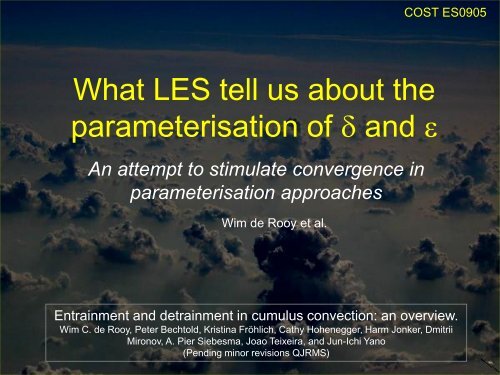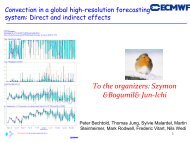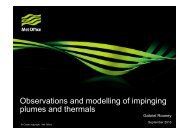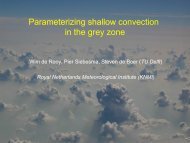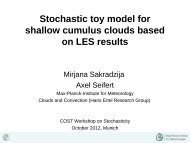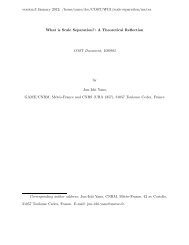What LES tell us about the parameterisation of and - Convection
What LES tell us about the parameterisation of and - Convection
What LES tell us about the parameterisation of and - Convection
Create successful ePaper yourself
Turn your PDF publications into a flip-book with our unique Google optimized e-Paper software.
COST ES0905<br />
<strong>What</strong> <strong>LES</strong> <strong>tell</strong> <strong>us</strong> <strong>about</strong> <strong>the</strong><br />
<strong>parameterisation</strong> <strong>of</strong> <strong>and</strong> <br />
An attempt to stimulate convergence in<br />
<strong>parameterisation</strong> approaches<br />
Wim de Rooy et al.<br />
Entrainment <strong>and</strong> detrainment in cumul<strong>us</strong> convection: an overview.<br />
Wim C. de Rooy, Peter Bechtold, Kristina Fröhlich, Cathy Hohenegger, Harm Jonker, Dmitrii<br />
Mironov, A. Pier Siebesma, Joao Teixeira, <strong>and</strong> Jun-Ichi Yano<br />
(Pending minor revisions QJRMS)
COST ES0905<br />
Parameterisations <strong>of</strong> detrainment <strong>and</strong> entrainment are<br />
extremely important in NWP <strong>and</strong> Climate models.<br />
(see e.g. Murphy et al. 2004).<br />
They should have a sound physical bases:<br />
–Observations (e.g. Jonas 1990, Rodts et al. 2003)<br />
-<strong>LES</strong><br />
Direct translation from observation to <strong>parameterisation</strong> is<br />
cumbersome<br />
Most important tool to evaluate <strong>and</strong> diagnose <strong>and</strong>
Why are <strong>LES</strong> so important?<br />
<strong>LES</strong> domain NWP gridbox<br />
NWP- or Climate model:<br />
)<br />
t<br />
<br />
(<br />
' '<br />
w<br />
z<br />
F<br />
<br />
w ' '<br />
= total turbulent transport<br />
(sub grid for NWP models)<br />
'<br />
w ww<br />
'<br />
<br />
w'<br />
'<br />
<strong>LES</strong><br />
domain
= cloudy <strong>LES</strong> gridbox<br />
Convective transport<br />
c<br />
w'<br />
'<br />
a w'<br />
'<br />
(1<br />
a<br />
) w'<br />
'<br />
a<br />
(1 a<br />
)( w<br />
c<br />
c<br />
e<br />
c<br />
c<br />
<br />
1<br />
A<br />
c<br />
<br />
c cloudy<br />
area<br />
c<br />
c<br />
dxdy<br />
w)(<br />
<br />
)<br />
Define cloud with a conditional<br />
sampling, e.g.: 0 w<br />
0<br />
aw<br />
c<br />
v v<br />
(Siebesma & Cuijpers 95)<br />
q l<br />
c<br />
<br />
e)<br />
<br />
M<br />
( c<br />
<br />
)<br />
<br />
c( e<br />
Convective transport<br />
e<br />
c<br />
e<br />
Investigate bulk mass flux<br />
approach in <strong>LES</strong>
<strong>LES</strong> provide <strong>the</strong> experimental environment to investigate<br />
your (bulk) mass flux parametersation including all <strong>the</strong><br />
relevant processes like <strong>and</strong> <br />
Determine:<br />
Maw<br />
c<br />
z<br />
<br />
<br />
M<br />
( <br />
M<br />
z<br />
c c<br />
)<br />
c e<br />
describes <strong>the</strong><br />
updraft dilution<br />
<strong>and</strong> describe <strong>the</strong><br />
mass flux pr<strong>of</strong>ile<br />
•How well do your <strong>and</strong> compare to <strong>LES</strong>?<br />
•How do <strong>the</strong>y vary in <strong>LES</strong> <strong>and</strong> with what?<br />
•Can you capture <strong>the</strong> most important dependencies?<br />
<strong>LES</strong> should be leading in <strong>parameterisation</strong> development!<br />
However, in reality………….
Direct comparison <strong>of</strong> (dilution) with <strong>LES</strong>: Kain Fritsch<br />
BOMEX case: Kain Fritsch with optimal 0<br />
0.004<br />
<br />
KF<br />
<br />
<br />
2<br />
0 c<br />
=0.02* c<br />
2<br />
0.003<br />
0.002<br />
0.001<br />
<br />
<br />
KF<br />
2<br />
0 c<br />
0.000<br />
0.000 0.001 0.002 0.003 0.004<br />
+2h<br />
+3h<br />
+4h<br />
+5h<br />
+6h<br />
+7h<br />
+8h<br />
+9h<br />
+10h<br />
+11h<br />
+12h<br />
+13h<br />
+14h<br />
+15h<br />
<strong>LES</strong><br />
+1h<br />
=1/(z-z i<br />
+500)<br />
0.004<br />
BOMEX case: =(z-z i +500) -1<br />
+1h<br />
+2h<br />
+3h<br />
+4h<br />
0.003<br />
+5h<br />
+6h<br />
+7h<br />
+8h<br />
+9h<br />
+10h<br />
0.002<br />
+11h<br />
+12h<br />
+13h<br />
+14h<br />
+15h<br />
0.001<br />
0.000<br />
0.000 0.001 0.002 0.003 0.004<br />
<strong>LES</strong><br />
Kain Fritsch not very suitable for describing <strong>the</strong> dilution (cloud top!)
COST ES0905<br />
Dependence <strong>of</strong> on RH <strong>of</strong> <strong>the</strong> environment?<br />
Two operational<br />
<strong>parameterisation</strong>s:<br />
<br />
<br />
KF<br />
2<br />
0<br />
c<br />
0(1.3<br />
RH)f<br />
Bechtold<br />
scale<br />
Increasing with RH e !<br />
Decreasing with RH e !<br />
Setup RH experiment: Derbyshire et al. 2004<br />
Bechtold et al. (2008)<br />
Dependency RH e<br />
Not yet established
There is ano<strong>the</strong>r very important feature<br />
that should be represented correctly:<br />
The mass flux pr<strong>of</strong>ile<br />
<strong>and</strong> both influence <strong>the</strong> mass flux pr<strong>of</strong>ile<br />
However<br />
•Variations in <strong>the</strong> mass flux pr<strong>of</strong>ile are strongly<br />
dominated by !<br />
•Empirical arguments<br />
•Theoretical arguments<br />
De Rooy & Siebesma 2008, 2010
Empirical arguments<br />
Much larger variation in from case to case, hour to hour, different cloud sizes<br />
Jonker et al., 2006 Hohenegger, 2011
Empirical arguments<br />
Optimal fixed <strong>and</strong> <strong>LES</strong><br />
Optimal fixed <strong>and</strong> <strong>LES</strong><br />
ARM<br />
ARM<br />
De Rooy & Siebesma, 2008
Cloud layer<br />
Theoretical arguments<br />
Based on general in-cloud budget eq. for q t <strong>and</strong> making a distinction<br />
between small <strong>and</strong> large-scale lateral mixing (de Rooy & Siebesma 2010)<br />
Cloud ensemble<br />
(divergent condition)<br />
<br />
<br />
turb<br />
<br />
dyn<br />
turb<br />
<br />
<br />
dyn<br />
~<br />
1<br />
M<br />
1<br />
M<br />
M<br />
z<br />
<br />
<br />
M<br />
~<br />
z<br />
1<br />
~<br />
z<br />
Included in:<br />
de Rooy & Siebesma 08<br />
Neggers et al. 09
<strong>What</strong> are <strong>the</strong> consequences?<br />
As far as variations in <strong>the</strong> (non-dim) mass-flux pr<strong>of</strong>ile concerns:<br />
Use a (simple) fixed function for but a flexible <br />
=<br />
Parameterise <strong>the</strong> mass-flux pr<strong>of</strong>ile<br />
So no explicit <strong>and</strong> for M pr<strong>of</strong>ile!<br />
Unconventional:<br />
Separate entrainment (dilution) <strong>and</strong> mass flux pr<strong>of</strong>ile!<br />
De Rooy & Siebesma 2008 (RACMO, Harmonie) <strong>and</strong> Neggers et al. 2009
Parameterising <strong>the</strong> mass flux pr<strong>of</strong>ile<br />
<strong>LES</strong><br />
large c<br />
High RH e (friendly environment)<br />
Very buoyant updraft(s)<br />
Slow decrease M with height<br />
small c<br />
Low RH e (hostile environment)<br />
Marginally buoyant updraft(s)<br />
Fast decrease M with height<br />
Model <strong>parameterisation</strong><br />
Parameterisation mass flux pr<strong>of</strong>ile (or ) is dependent<br />
on properties <strong>of</strong> <strong>the</strong> environment <strong>and</strong> <strong>the</strong> updraft itself!<br />
De Rooy & Siebesma, 2008
0 (1.3 RH)<br />
Bechtold f scale<br />
Traditional scheme<br />
<br />
Bechtold et al. 2008<br />
COST ES0905<br />
Setup RH experiment: Derbyshire et al. 2004
Concl<strong>us</strong>ions/Recommendations<br />
• <strong>LES</strong> are very important:<br />
– Fundamental studies <strong>and</strong> (Romps, Dawe & A<strong>us</strong>tin)<br />
– Investigate <strong>and</strong> in bulk (model) framework<br />
• Parameterisations <strong>of</strong> , should be based on <strong>LES</strong> (i.o. tuned in<br />
model) describing <strong>the</strong> right processes.<br />
• Detrainment is responsible for variations in <strong>the</strong> mass flux pr<strong>of</strong>ile<br />
(due to variations in cloudlayer depth, environment <strong>and</strong> updraft).<br />
Separate <strong>parameterisation</strong> <strong>of</strong> mass flux <strong>and</strong> dilution ()<br />
– Theoretical <strong>and</strong> empirical arguments<br />
– More flexibility<br />
– Rob<strong>us</strong>tness<br />
• Keep parameterizations as simple as possible.<br />
J<strong>us</strong>t enough complexity to include <strong>the</strong> most relevant processes
A popular traditional scheme:<br />
Kain Fritsch (buoyancy sorting)<br />
(1-)θ vu<br />
()θ ve<br />
vu<br />
c<br />
1<br />
v<br />
positive buoyant<br />
mixtures<br />
negative buoyant<br />
mixtures<br />
ve<br />
Courtesy: Stephan de Roode<br />
0<br />
fraction environmental air ()


